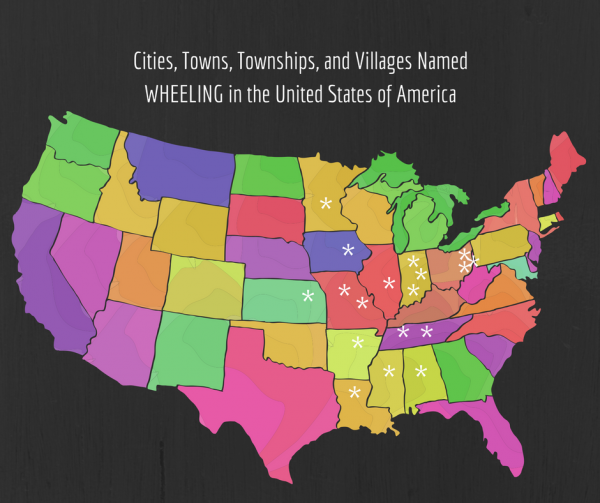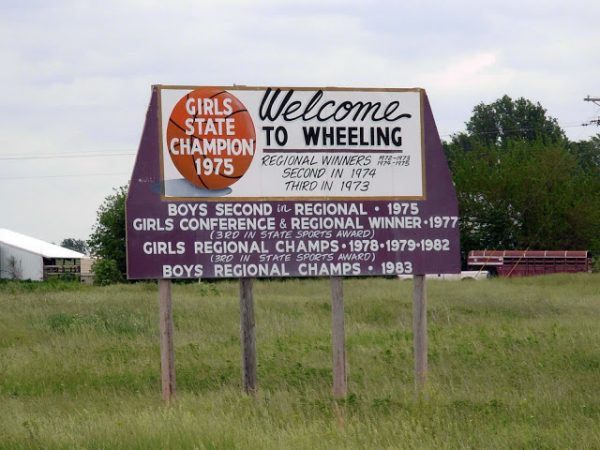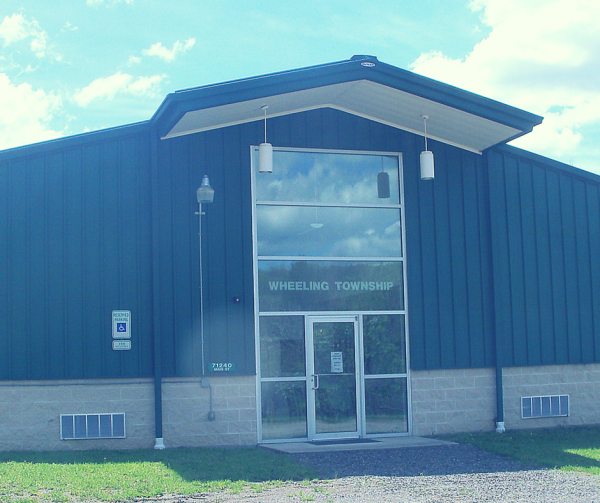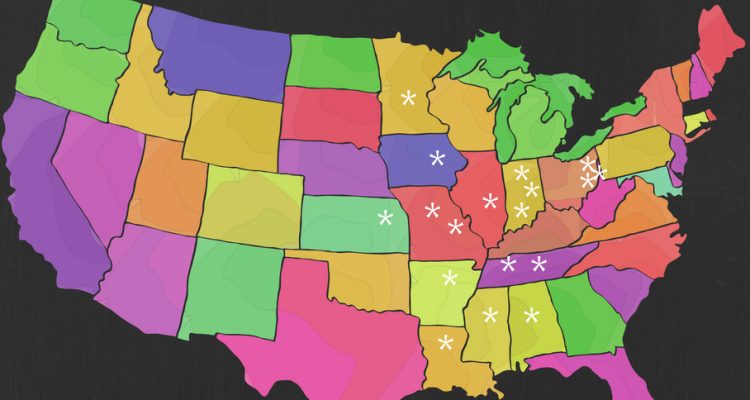The settling of Wheeling, W.Va. (then Virginia), by the Zane family is a story common to most locals. In 1795, white settler Ebenezer Zane changed the name of the area he had claimed through tomahawk rights from Zanesburg to Wheeling. The town was incorporated in 1805, and in 1836, Wheeling was incorporated as a city.
It is the origin of the city’s name that remains a source of fascinating controversy. According to researchers, Wheeling is from a Delaware (Lenni Lenape) word for “place of the head.” In the Delaware language, whiling or whi-link, which means, according to many sources, “where the head is, or place of the head,” which could indicate rather benignly the head of the creek. In this case, Wheeling Creek.
According to an 1833 book by John Heckewelder, Wheeling got its name in a more sinister way from the Lenni Lenape. “The Indians report that a prisoner taken by them in one of their wars had there been put to death and his head stuck up on a sharpened pole.” Heckewelder, who lived outside of Philadelphia, spent his entire career studying the Delaware people, their customs and language; therefore, his authority on this issue is well established. Other derivations of the word include weal-ink and weelunk. (The latter being the inspiration for the publication you are currently reading.)
Regardless of meaning, it is easy to understand why Native Americans had occupied Wheeling for centuries before white settlers reached the area. The rolling hills and fertile river valley allowed for ample farming, hunting and access to other parts of the country via boats. By the time Zane arrived in the 1700s, the land already had been explored and claimed by many cultures. In the decades that followed, Wheeling became an incredibly prosperous city due to its location and the industriousness of its citizens. Its impact on the nation cannot be denied. At one point, over half of the glass in the United States was made in either Pittsburgh, Pa., or Wheeling. It was also a countrywide leader in the production of stogies, steel and nails. And, of course, Wheeling was the first capital of the state of West Virginia.
It should be no surprise, then, that as people journeyed from this bustling river town that they were inspired to found their own little Wheelings. Research shows that at one time or another in the 1800s, there were more than a dozen villages, towns, townships or cities named Wheeling in the U.S. I wanted to know more about those other Wheelings, and I thought you might, too.

The Other Big Wheeling
Wheeling, Ill., a Chicago suburb, is the largest and most successful village named after Wheeling, W.Va. Miami Indians lived in the area when LaSalle explored the region in 1681, and later the Pottawatomie occupied the area until 1833 when they were coerced off their land by treaty. Soon after, white settlers flooded the region, and it became known as an overnight stop for travelers from Chicago who were headed to the Wisconsin Territory via the trail running through Wheeling now known as Milwaukee Avenue. Inns, taverns and diners established during the 1830s became known as Restaurant Row, which remains a vital part of the village’s business district. Today, the thriving village is home to nearly 40,000 people. The Wheeling rail station supports commuters who travel into Chicago and Antioch for work and play.
From Mannington to Missouri
According to Henry Gannett’s 1902 book, “The Origin of Certain Place Names in the United States,” Henry Nay platted the city of Wheeling, Livingston County, Mo., in 1865. As other historical documents show, Nay was from Mannington, Marion County, (West Virginia), which is southeast of Wheeling. Following his service in the Civil War, he packed up and headed west, bound for California, but he stopped in Missouri. There he created a town he called Wheeling after the capital of the newly minted state of West Virginia.
Henry is a fascinating figure. He was a blacksmith by trade and served the Union Army during the Civil War. He and the troops he commanded protected the train station in Mannington, W.Va. Railroads shipped goods and persons where needed during the war, so disruption of service had catastrophic impacts on the war’s outcome. In one report, Nay is listed as being present with other members of the 176th infantry at John Brown’s raid on the arsenal in Harper’s Ferry.
Although I could not prove that Henry Nay was at John Brown’s raid, a collection of letters, written by Henry Nay and housed in the West Virginia Adjutant Generals’ Papers in the state archives, reveals that Nay was indeed a colonel of the 176th infantry. Over the course of the war, he writes to high-ranking state officials. In an 1863 letter to West Virginia’s first governor, Arthur I. Boreman, he requests firearms to protect Marion County from neighbors who are armed and “fighting their way to the southern army.” Nay speaks urgently about the need to serve the state by stopping these people. “We have no means of resistance,” he writes. “We have no arms. They will strip our county if allowed to persist in their course.”
The Wheeling that Nay would later found grew to be a successful center of commerce and industry. Although Wheeling, Mo., today is small with just under 300 residents, it has had its share of the spotlight. One of its residents, Lawrence Walkup, was the 11th president of Arizona University for 22 years. He was buried in Wheeling, Mo., in 2010.

Wheeling, Iowa
Many people left Wheeling, W.Va., to build new lives in the West. The Polson family did just that in 1850. Along with the Rankin family, the Polsons, led by Thomas, formed the town of Wheeling in 1851. It had a blacksmith and postmaster, and not long after, a doctor and a dry goods store. The name Wheeling, according to “History of Marion County, Iowa and Its People” (1915), “was suggested by Henderson Polson, Thomas’ son, after Wheeling, West Virginia.” Although born in Indiana, Henderson must have loved the family stories about their home state. Today, Wheeling, Iowa, is an unincorporated community.
The Ohio Wheelings
Just across the river from Wheeling, two Ohio counties possess Wheeling townships. Wheeling Townships in Belmont County, Ohio, was platted in the early 1800s. According to historical records, Wheeling Township is named for Wheeling Creek, which flows throughout Belmont County. (Note that this is not the same Wheeling Creek that runs through Wheeling, W.Va.) Given that Ohio’s Wheeling Creek had alternative names documented in the historical record such as Indian Wheeling Creek, Scalp Creek and Spit Head Creek, it calls into question (or maybe confirms) the story that Wheeling Creek in West Virginia was named after a settler’s head being placed on a spike as a warning to other settlers.
In any case, Wheeling Township in Belmont County was known for its wheat production. According to “Centennial History of Belmont County, Ohio,” the Wheeling Creek Valley was “unrivaled” in its production of wheat between 1820 and 1845. Farmers were growing anywhere from 100 to 500 bushels of wheat per year, and the 10 grist mills in the region worked 24 hours a day to make flour for shipment down the Ohio to Louisiana.
Belmont County boasts another Wheeling. West Wheeling was founded in 1838. Its existence is interesting to many persons in Wheeling, W.Va., which has a North Wheeling, South Wheeling, East Wheeling and even a Centre Wheeling, but not a West Wheeling. According to the “Centennial History,” the principal employer in West Wheeling in 1903 was a paper mill, but “many of the employees of the factories and mills in the city of Wheeling opposite [West Virginia] make their homes in West Wheeling, crossing and re-crossing the river by the old ferry that was established in the early history of the village.” In a sense, then, Wheeling, W.Va., does have a West Wheeling, but it is in Ohio. Today, West Wheeling is part of Bridgeport, Ohio.

Wheeling Township in nearby Guernsey County, Ohio, was founded in 1810. One of the early settlers, Robert Atkinson, came from the Wheeling, W.Va., area. His wife died not long after they built their cabin. Atkinson returned to West Virginia to find a new wife. While he was gone, his neighbor, a man known only to history as Bird, loaded a boat with Atkinson’s household possession and floated downstream to the Muskingum River and was never heard from again. To this day, there is an area of Wheeling Township in Guernsey County called Bird’s Run. It is an unincorporated community.
For a short time, New Wheeling existed in Holmes County, Ohio, which today is known for its Amish community, which was established in 1808. New Wheeling didn’t last long, and today it is included on lists of Ohio ghost towns. There are no known physical remnants of the town.
EDITOR’S NOTE: Part one of this essay explored several of the most commonly known Wheelings. Tomorrow’s part two explores Wheelings in Indiana, the South and in places rather unexpected.




